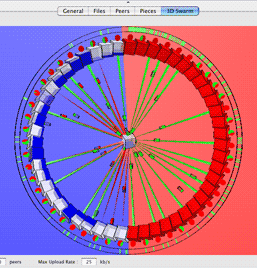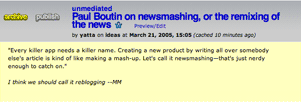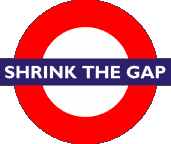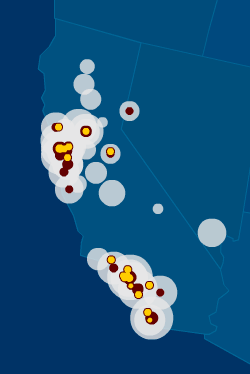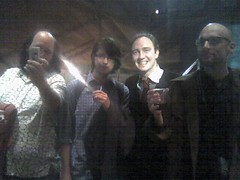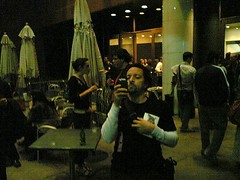tecznotes
Michal Migurski's notebook, listening post, and soapbox. Subscribe to ![]() this blog.
Check out the rest of my site as well.
this blog.
Check out the rest of my site as well.
Mar 29, 2005 8:01am
mappr mentioned by people we respect
Four nice write-ups about Mappr today.
Thomas alerted us that the Wall Street Journal has a piece about online photo sites:
Sometimes, the results are remarkable. Mappr's programmers searched Flickr for all shots tagged "Route 66," and then plotted them. Sure enough, the pictures wound from Chicago to L.A., with stops in Kingman, Barstow and San Bernardino. Oh, so pretty.
There is also a PC Forum recap in Barron's. Mappr is Stanford GIS website of the week, and Penn State has a class on new media and digital arti criticism which uses Mappr as an example, along with Cassidy's Graffiti Archeology and In The News arch-rival and beater-to-the-punch Newsmap.
I'm especially tickled by the academic links.
Mar 25, 2005 6:14am
bits on wheels - a fan letter
Bits On Wheels is a Mac-only Bittorrent client. It's freeware (but not open source or public domain) and it looks like this:
It has the usual Bittorrent features, and runs a little faster than my other client, Azureus.
The neat thing that sets it apart is the 3D swarm view, shown above. Bittorrent works by enabling participants to self-organize into a swarm: a group of machines group-hosting a particular file at a given time. When you connect to a Bittorrent tracker, your client can coordinate with others also connected to that tracker. Machines with the entire file are called seeders; they share pieces of the file with machines seeking the file. It's akin to book printing through coordinated xeroxing: I'll do the first ten pages, you do the next, then we trade. Easy.
The 3D swarm view shows yourself in the center. Hosts you are connected to lie around the periphery: although a Bittorrent swarm can be a complex graph, the swarm view is self-centered. Hosts around the edges may be connected to each other, but that is not shown.
Each host is represented by a translucent box, whose filling represents the percentage of the file that host has. As you obtain more pieces of the file, your box slowly fills up to 100%. Connections to those hosts are shown as spokes on the wheel, along which data packets travel. Links are bidirectional (you can be sending pieces to a host that you are also grabbing pieces from), and data travels along the spoke at a rate representative of your connection speed. Speedy connections are immediately apparent, as are stalled ones.
The colored circular rail fills up with green as you get more of the file. The screen shown above shows how much of the file I have, and which parts. Each host-box also has a little pie-chart above it, for which I haven't yet found a satisfactory explanation. I'm guessing it shows a host's share ratio, the relative amount of data uploaded vs. downloaded.
The hosts are divided into seeders and leechers: seeders have a red background, and they are completely full. These are hosts that already have the entire file, but are continuing to share more. Leechers are on the blue background, and they are hosts seeking pieces of the file. When your client has successfully downloaded 100% of the file, the background becomes solid-blue: you no longer need to be connected to other seeds, because you yourself are now sharing the entire file.
The beautiful thing about Bits on Wheels is the way in which it makes this process visually coherent. The first few times I tried it, I was mesmerized for up to twenty minutes at a time, watching the connections speed up or slow down as hosts came and went.
I don't think I really grokked Bittorrent until I used this app.
The one thing I would change about it would be to add RSS awareness. Or, to remove the mandatory "where do I save this?" dialog at open-time so I can add my own commandline RSS parser onto it, without having to learn AppleScript.
Mar 22, 2005 1:35am
rebloggin'
I'm Eyebeam's reblogger of the fortnight. This means that I spend a chunk of every day reading through Eyebeam's enormous base of subscribed RSS feeds, picking the choicest bits of information that I find particularly noteworthy/interesting.
As anyone who plays guitar knows, interesting things happens when outputs are connected to inputs:
That's a Slate article about "newsmashing" (reblogging, basically), posted to Jason Kottke's remaindered links, reblogged by me, re-reblogged by yatta at unmediated, found in my RSS reader, and currently re-posted here. I'll refrain from re-re-reblogging it even though I can.
Mar 20, 2005 10:29pm
e-tech, done traveling
I returned from e-tech a few days ago with a wicked cough. We were comped at the last minute by Nathan Torkington, who also extended an invitation to present our MoveOn national town hall at this summer's Where 2.0. More on that later. It was my first time at the conference, and was truly a blast.
Some highlights:
- George Dyson's talk, Von Neumann's Universe. This was an inspirational look back on the history of computing, through the eyes of an historian and family member of the tight circle of mathematicians and physicists responsible for digital computing.
- The BBC presentation (Tom Coates, Matt Biddulph, Matt Webb and Paul Hammond) describing experiments in SMS-driven playlist selection. Remarkable less for the technology presented, and more for the difficulty I had in imagining a bottom-line-driven U.S. media conglomerate donating the same effort to skunkworks-style experimentation resulting in actual air-time (10 hours!).
- Cory Doctorow's talk, All Complex Ecosystems Have Parasites. Cory practically phoned this one in, but the message about learning to love chaos in a vibrant internet is an important one for would-be regulators to understand
Some Not-so-highlights:
- Jason Fried's talk on Basecamp and Ruby on Rails. The IRC backchannel was truly merciless during this one, most likely because it was a peppy sales pitch completely innappropriate for the context. Basecamp and RoR are both supposedly pretty great, but prefacing almost every sentence in a presentation with "Do..." or "Don't..." is an awful way to address a technology-aware audience, especially if you use constructions such as "Don't worry about [technological concern], except when you have to." Thanks... knowing when you have to worry about something is the the hard part.
Actually, that's the only low point for me. Overall, a fantastic experience.
Mar 15, 2005 6:50am
the gates: memory blog
I added a few words to the Gates Memory Blog today.
... When I look at the 2,000 images that have been submitted so far, I'm amazed by the formal games you can play. Photos of the same place, or photos at the same time. Iconic viewing angles. Single gate against blue sky. Saffron fabric against sunshine. Rows of gates receding to a vanishing point. Rows of gates crisscrossing the frame. Gates framing people. Gates framing other gates. Gates photos in a pile, gates browsable by tag. ...
Mar 14, 2005 3:38pm
off to e-tech
I'm heading to San Diego tomorrow morning, to catch two days' worth of O'reilly's Emerging Technology Conference, thanks to a windfall last-minute comp from Nathan Torkington.
Mar 11, 2005 3:47am
latest moveon event
MoveOn used Stamen's collaborative mapping software again tonight, with an online town hall meeting that featured calls from Howard Dean, Senator Harry Reid, and Adam Ruben.
It was great to hear two things:
Recognition of linguist and cognitive scientist George Lakoff's ideas about self-aware language usage in politcal speech. It's not a matter of arguing your point, it's a matter of framing it to drive home the underlying values. Social justice, in the case of Dean's talk.
Black box Voting: It's about time this country took voting technology seriously. Dean mentioned the specific example of Oregon, which requires that all voting technology used in the state supports manual recounts. This issue has been covered extensively in such forums as Slashdot, and it's really pretty simple. How is it that national elections in the US have been twice marred by "irregularities", while a low-tech purple-thumb in Iraq ensured that no voters were able to defraud the system?
Agh.
Mar 8, 2005 6:58pm
json-php and mappr updates
Two things I did with my unusually productive morning:
- Created a Yahoo! group for my JSON-PHP project, at Matt's suggestion.
- Added Worldkit-style geo: tag support to Mappr.
Mar 8, 2005 2:25am
in l.a.
On Thursday night, I had got to get up in front of a large auditorium full of people and talk about our work, for the second time in my life. The event was the launch party for USC's IML Vectors Journal. We worked with Erik Loyer to develop two of the journal's interactive articles, The Unmaking of Markets and Narrating Bits. My In The News project from last year was also included.
I get incredibly apprehensive in front of crowds: palms sweating, blood rushing, frantically scribbling a few notes so I don't blank, trying to picture the audience naked. When Andy and I first performed as BiPole, I spent the first 5 minutes of the set freaking out trying to replace a dead co-ax cable, and the remainder sweating while he pounded out a significantly more gabber-oriented set than I expected. Somehow, my up-front crowdfear and anxiety usually gives way to complete contentment by the time everything's over if I'm able to find a drink. It seems like the proper way to handle fear of speaking in front of groups, is to do it often enough that it becomes second-nature.
The biggest advantage of doing these things is that you inevitably meet the most interesting people afterwards. We were approached by Bob Stein from Future of the Book who had some nice things to say about Mappr back in January. We also got to visit Julian Bleecker at the ZML (URL MIA) where he showed some of his wi-fi art/tech projects.
Eric and I have been talking a bit about resurrecting 16thandmission, and a few of Julian's ideas about place-specific wireless access sound like a good fit. I don't know if the plaza at 16th and Mission has any signal now. Providing freebie coverage may help further rid the location of its junkie-stigma, especially since the city has recently rebuilt the square, and provided brighter lighting. We wouldn't be able to install any wi-fi equipment on-site, but our office is across the street, and I'm sure that there's a way to set up a reverse-cantenna for saturated directional coverage, instead of reception.
